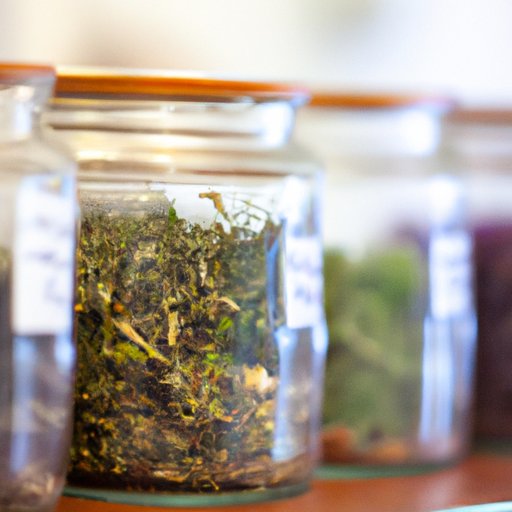I. Introduction
Infusions have become increasingly popular among foodies and home cooks alike as a way to add new flavors and dimensions to their dishes. In this comprehensive guide to infusing, we will cover all the basics of what an infusion is, how to make one at home, the history and cultural significance of infusions, and even how to use infusions in creative cooking recipes.
II. Infusion 101: The Basics of How to Infuse Herbs, Spices and More
Before we dive into the science and history of infusions, let’s start with the basics. An infusion is essentially a flavored liquid that is made by soaking herbs, spices, or other ingredients in a liquid base such as water, oil, vinegar, or alcohol. This process allows the liquid to absorb the flavors, colors, and other properties of the ingredients.
There are many different types of infusions, but some of the most common include:
- Oil Infusions: where herbs, garlic, or other flavorings are steeped in oil for use in salads, marinades, or cooking.
- Vinegar Infusions: where fresh herbs, fruit, or spices are steeped in vinegar for use in dressings, condiments, or pickling.
- Spirit Infusions: where herbs, fruit, or spices are steeped in alcohol to create flavored liqueurs, cordials, or cocktails.
To make your own infusion at home, simply follow these steps:
- Choose your base (oil, vinegar, or alcohol).
- Select your ingredients (herbs, spices, fruit, etc.).
- Combine base and ingredients in a jar.
- Store in a cool, dark place and let steep for a few days to a few weeks.
- Strain out the solids and use as desired.
III. The Science Behind Infusions: How Liquids Absorb Flavors and Properties
The science behind infusions is rooted in molecular chemistry. Specifically, the process of steeping involves the transfer of flavor compounds, aromatic compounds, color compounds, and other properties from the ingredients to the liquid base. This occurs through a process known as diffusion, where molecules move from areas of high concentration to areas of lower concentration until they fill the entire space.
Infusions are particularly effective at capturing the properties of ingredients because the liquid base acts as a solvent, breaking down the cells of the ingredients and allowing the compounds to be released. Additionally, the steeping process creates a concentrated flavor that is not possible through other cooking methods.
IV. Exploring the History and Culture of Infusions: From Tea to Cocktails
Infusions have a long and rich history that dates back to ancient cultures around the world. For example, tea ceremonies have been an important part of Japanese and Chinese culture for centuries, while the use of herbs in medicinal infusions dates back to Ancient Egypt and Greece.
In more recent times, infusions have become part of popular culinary culture, particularly in cocktail making. Infused spirits and liqueurs are now a staple of mixology, allowing bartenders to create unique and complex flavor combinations. In many ways, the infusion trend represents a desire for individuality and creativity in our culinary experiences.
V. DIY Infusions: How to Make Your Own Flavored Oils, Vinegars and Spirits
Making your own infusions is a great way to experiment with different flavors and impress your dinner guests. Here are some tips for making your own infused liquids:
- Choose fresh, high-quality ingredients.
- Wash and dry your ingredients thoroughly before using.
- Use a clear container to monitor the infusion progress.
- Store in a cool, dark place away from direct sunlight.
- Experiment with different steeping times to find your desired level of flavor intensity.
VI. The Health Benefits of Infused Water: Boosting Your Immune System, Digestion, and More
Infused water is a popular way to stay hydrated and reap the benefits of delicious flavors and health properties. Some of the benefits of drinking infused water include:
- Boosting your immune system with vitamin C and antioxidants found in fruits like lemon and berries.
- Aiding digestion with herbs like mint and ginger.
- Reducing inflammation with ingredients like cucumber and basil.
- Promoting weight loss by replacing sugary drinks with naturally flavored water.
Some tasty infused water recipes include:
- Lemon and raspberry
- Cucumber and mint
- Strawberry and basil
- Orange and blueberry
VII. From A to Z: Different Types of Infusions and Their Unique Uses
There are many different types of infusions that range from simple to complex, sweet to savory, and everything in between. Here are a few examples:
- Tea Infusions: Used for hot or cold tea drinks, tea infusions can add new dimension to traditional black or green tea.
- Coffee Infusions: Used in baking and cooking, coffee infusions are great for adding a depth of flavor to chocolate desserts or marinades for meats.
- Liqueur Infusions: Used in mixology, liqueur infusions are great for creating custom cocktails or adding to a classic after-dinner drink.
- Soup and Stock Infusions: Used in soups and stews, stock infusions can add a new depth of flavor and complexity to your favorite comfort dishes.
VIII. Infusing Creativity in the Kitchen: Creative Cooking Ideas Using Infused Ingredients
Once you have made your own infusions, be sure to try incorporating them into your cooking recipes for extra depth and flavor. Here are some ideas to get you started:
- Use infused oils in salad dressings or marinades.
- Use vinegar infusions for pickling or marinades for vegetables.
- Use spirit infusions in cocktails or desserts like tiramisu.
- Use tea or coffee infusions in baking or rubs for meat.
IX. Conclusion
Infusions are a versatile and creative way to add new flavors and dimensions to your cooking. Whether you are making your own infused oils, vinegars, and spirits, or trying out new infused water recipes, there are endless possibilities when it comes to experimenting with infusions in your culinary creations.
